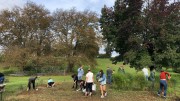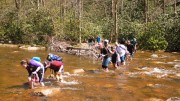Summer of 2022 at McDaniel Local was yet another success in immersing first year students into the McDaniel and Westminster community. McDaniel Local is focused around giving first year students a sense of place in the community. The McDaniel Local class of 2026 participated in different forms of community service including volunteering at the Boys and Girls Club of Westminster and participating in the creation of a continued riparian forest buffer at the McDaniel Environmental Center.
Students in the class of 2026 planted over 400 plants to create this buffer. The riparian buffer is a barrier of vegetation along the sides of the stream that goes through the McDaniel Environmental Center property, unofficially but fondly called McDaniel Run by involved students and faculty members. As a restoration fellow employed by Dr. Scullion, Chair of the Environmental Studies department, I had the privilege of engaging with the class of 2026 and helped teach them about the McDaniel Environmental Center and how to create this astounding forest buffer.
Students from different local sessions planted in four different sites along the stream. Several different kinds of trees and shrubs were planted throughout the summer to create the buffer. The intention of the buffer is to protect the stream from pollutants that may run off from the housing or neighboring agricultural sites.
Once developed, the roots of the trees and shrubs will capture and uptake pollutants and nutrients to decrease the amount entering the stream. Not only is this benefitting the stream on the McDaniel property, but the stream also flows into the Potomac River, and ultimately the Chesapeake Bay. By planting this buffer, students of 2026 are participating in something so much bigger than our little McDaniel Community.
Students were able to learn the significance of these plantings and how they were helping the future of not only the McDaniel environment, but the future of the Chesapeake Bay. While helping the environment in several ways, students were able to connect with each other and help each other do their part in creating a better future for themselves and their environment.
Many students made a personal connection to their service and marked their plants with rocks and sticks so they will be able to come back in the future and see the environmental masterpiece they have created.
The class of 2026 will be able to return to the McDaniel Environmental Center in 20 years and be able to see the forest they planted together as a community and see the impacts of their hard work in the trees, the soil, the stream, and the bay.
Dr. Jason Scullion explained the importance of these experiences and said, “McDaniel Local at the MEC gives students the opportunity to learn about the natural environment they will call home for the next four years while giving them a chance to make friends and contribute to their community.”
Another restoration fellow, Garrett Tucker, explained his view on the impact of the project.
“The local sessions had a really positive impact on the students. We had lots of them with little to no experience outdoors and watching them coming in scared of dirt and the forest and leaving with huge smiles on their faces, I thought was really amazing,” Tucker said.
“The McDaniel Run will look completely different in ten years and more healthy than it would have been before,” Tucker said.
These kinds of impacts on students and the environment will last forever. The importance of community at McDaniel is everlasting. Students coming together to create a better world for themselves, and others is a productive way for students to build a community that will last them forever in their memories and in the forest.




